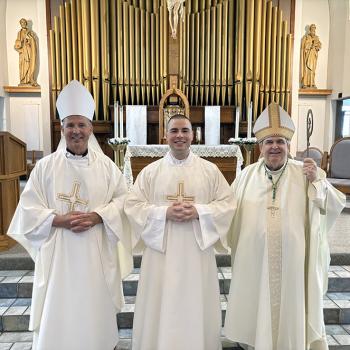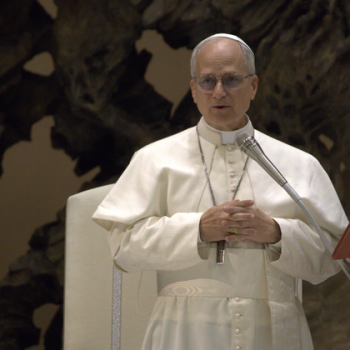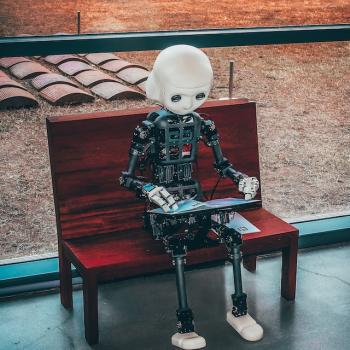Communion works to bring the whole of creation into Christ. The world is transfigured, the world participates in the eucharistic transformation, with the eucharist itself being a participation of the eschatological feast where Christ will be all in all. By partaking of the eucharist, we find ourselves drawn into Christ; we are made one with him. By being made food, Christ has found a way to join himself with us, to have us take him in and transform us from the inside out. We become united with Christ, for we become what we eat. “Now when the body of Christ is eaten, not what is eaten but he who eats is incorporated with Him whom he eats. On this account Christ wished to be eaten by us, that He might incorporate us with Him.”[1]
The world itself found Christ’s body and blood, his living tissue, within itself and so was also taken in by it; it too, can be and is transformed from the inside out. Christ’s body was like every other human body; he would have had sweat dripping from his brow, he would have had hair and skin being discarded into the earth, giving himself to the world and letting it thrive. The eco-system of the world shows that we are food to each other, we give life to each other, in many ways; what dies becomes food for something else. Christ has become food for all, each in their own unique way, so that all can thrive and be transformed with him, to move from the fallen, imperfect world where the negation of being, sin, tries to destroy creation, to that which is real and true, that which is eternal, as it is incorporated in Christ. “God’s power descends into the world and transforms it at definite moments and points, filling it with another life.”[2]
The mystery of the eucharist show that matter itself is affected, that it has had an internal transformation:
Sacrament transubstantiates the cosmic and makes it transcendent in relation to the world, in relation to itself; the nature of the cosmic becomes an incarnate antinomy, because, on the one hand, it’s ‘matter’ is necessarily cosmic, belongs to this world (otherwise the sacrament would not be accomplished, for it must have an object, is accomplished in the world and above the world), and, on the other hand, it makes the matter transcendent in relation to itself.[3]
When one thinks about Gnosticism and its denial of the reality of the world, one would then find it unlikely that any Gnostic would have a eucharistic view of the incarnation. The two seem to go against one another. If one believes the world is illusory, the incarnation seems to be about the presence of the transcendent in the world to break open the world and to lead us out of its grip. However, Philip K. Dick, who saw himself as a Gnostic, who truly held many Gnostic views, nonetheless also held a very eucharistic view of the incarnation. Christ, for him, was really incorporating the world in himself. By that process, what is illusory and fake could become real. This is an interesting take for a Gnostic, and one in which the Gnostic predisposition against the world can be found, however, it is also something which can almost be said to be based upon an orthodox understanding of the world. The world is, in a way, illusory; the world does not meet its essence, and is less than itself; sin negates being, it destroys it from the inside, so that all one has is a shell of being, a shell which points to what it should be but is not. And in this way, Christ’s incorporation of himself into the world so that the world can be incorporated in him is thus the restoration of being to the world, of making the world real and alive, filled with the radiance of O WN. Thus, PKD, though coming to the incarnation with Gnostic overtones in his thought, nonetheless is capable of appreciating the way the incarnation transubstantiates the world, makes it real, and indeed, how God uses the ways of the world itself for its own benefit.
Zebra counterfeits the counterfeit – which fits the Gnostic idea of the bumbling demiurge being helped out, out of mercy, by the true God. This helping out, not just of humans but of the whole fallen (fucked up, not really real) cosmos is the transubstantiation of objects and processes on an invisible ontological level which I saw the growing Corpus Christi achieving. A fake fake = something real. The demiurge unsuccessfully counterfeited the pleroma, and now God/the Savior is mimicking this counterfeit cosmos with a stealthily growing real one. What this all adds up to is that God, through the cosmic Christ, is assimilating our cosmos to himself.[4]
While we must be careful, and not believe the world was given its origin, its foundation, by some secondary force outside of the vision of God. God created the world out of nothing. However, there is a kind of demiurge in creation. The world itself was given its own ability to define itself, to have a form of self-making, and within creation, there are many who are given roles as subcreators. The bumbling demiurge can be seen as all those who live and thrive in creation, who have been given a role as co-creators with God but who failed to follow God and instead looked in on themselves and turned themselves into their own gods. Even then, in their idolatry, their role has not been denied, and so their God-given power to influence the development of the world and all that is within it becomes negative as their sin takes root in the world itself. The world is a world of fakes because the co-creator has turned away from the real, first in themselves, and then in the world at large. The real is touched, the real is drawn into their sub-creation, but sin deconstructs what is taken into the world and makes it less than it should be; what is good and true becomes cut up from within, and only the semblance of the good and true remain. Adam the first human was to be a mediator, to help elevate the world with his own theosis; but in his sin, the world fell with him, turning away from the eternal truth in God. Jesus Christ, God the Son, the Logos, took on the nature and way of humanity – even mortality – so that he can be a part of the world, to take the world from within, from within its imperfect, fallen mode of being, and bring it with him to the eschaton. “Thus then of His own will He bore mortality, that He might taste death and thus put mortality aside.”[5]
Philip K Dick, in his way, saw the work of the Logos transforming the world from within. We are like Pinocchio – we have been given life, but will we fully become transformed into real humans or remain trapped in a wooden imitation of humanity? The Logos, who is the second Adam, is also the true Adam, the one who allows us to become all that we are meant to be, and in him, we are then to be united in God. Communion, the eucharist, is the means of such transformation. In death, Christ was able to do more than give us himself as food – though it is through death, food is made; it is in death, Christ was able to give us the food which, when incorporated in us, is able to transform us so that he can take our place, he can take the pain and suffering of sin, the full karmic assault for our actions, replacing himself with us from within so that from without we can be saved:
This is the heart of the Christian mystery – and the heart of the issue, ‘where is our God (dues asbconditus)? where can he be found?’
Again: it is at the moment when the ultimate blow (of pain, murderous injury, humiliation and death) is struck, it is Christ who is there, replacing the victim and taking the blow himself. This is what happened to me in 3-74.[6]
Christ in the eucharist transforms us, “replaces us” from within; the wood becomes flesh, the flesh is alive, and we become who we really are because of our unity in Christ. PKD really caught on to what is so central to the Christian mystery, even if his Gnostic inclinations made him second-guess the full implications of what he had seen and experienced. The transformation is real, the world itself is to be made full, as we all become incorporated in and united with Christ. The world is not to be denied, but lifted up, to be transformed as the eucharistic elements are transformed — the physical appearance, the physical properties remain the same, appear to “mimic” the world, even as what they bring is something above and beyond the world and capable of making it what it is truly meant to be in Christ, who is to be all in all.
[1] Hugh of St. Victor, On the Sacraments of the Christian Faith. Trans. Roy J. Deferrari (Cambridge: The Medieval Academy of America, 1951), 307.
[2] Sergius Bulgakov, “On Holy Relics” in Relics and Miracles. Trans. Boris Jakim (Grand Rapids, MI: William B. Eerdman’s Publishing Company, 2011), 10.
[3] Ibid., 10.
[4] Philip K. Dick, Exegesis. ed. Pamela Jackson and Jonathan Lethem (Boston: Houghton Mifflin Company, 2011), 277.
[5] Hugh of St. Victor, On the Sacraments, 305.
[6] Philip K. Dick, Exegesis, 294.















